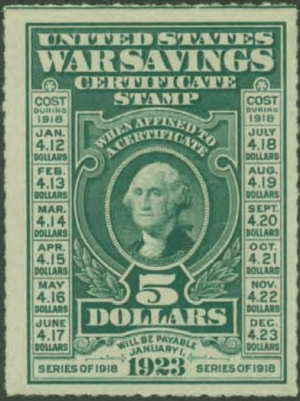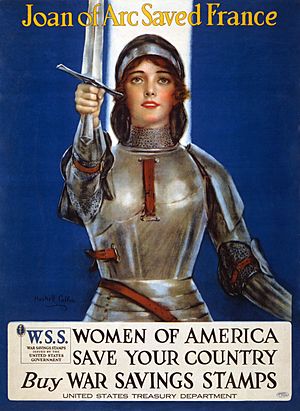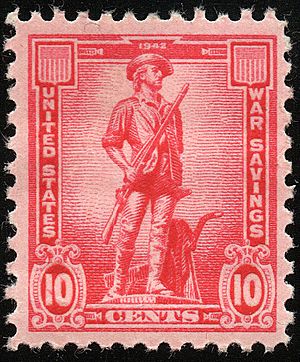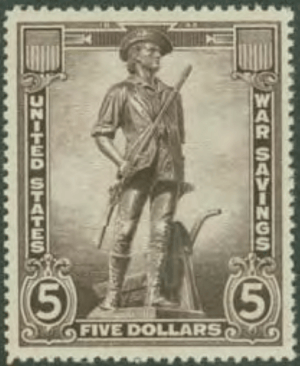War savings stamps of the United States facts for kids
War savings stamps were special stamps sold by the U.S. Treasury Department. They helped the country pay for its involvement in World War I and World War II. Unlike bigger Liberty Bonds that banks bought, these stamps were made for everyday people to buy. Even kids could buy them!
The United States Post Office Department helped a lot by selling and promoting these stamps. During World War I, small 25-cent "Thrift stamps" let people save up to buy a larger 5-dollar War Savings Certificate stamp. In World War II, the smallest stamp was 10 cents. This made it easy for almost anyone to help out. Often, if you collected enough stamps, you could trade them for special government certificates or War Bonds.
Contents
Helping Fund World War I
The U.S. Treasury Department started selling war savings stamps in late 1917. This was to help pay for the huge costs of World War I. The war cost the United States about $32 billion. By the end of the war, the government had borrowed $26.4 billion.
War savings stamps brought in about $0.93 billion. This was a smaller part of the total money needed. However, these stamps were important. They encouraged people to save money. Government leaders also used the program to teach everyone about saving and being thrifty.
The Main War Savings Stamps
The main stamp that earned interest was the War Savings Certificate stamp. It was worth 5 dollars when it matured on January 1, 1923. You had to stick these stamps onto a special folder. This folder was called the War Savings Certificate. It had the buyer's name and only that person could get the money back.
From December 1917 to January 1918, each stamp cost $4.12. If bought early, it offered a 4 percent return over time. The price of the stamp went up by one cent each month after January 1918. Sales ended in December 1918. You could also get your money back early. You would receive what you paid plus one cent for each month you owned it. New series of these stamps were issued in later years. They had the same interest rate and maturity time. The last ones were issued in December 1920, maturing in January 1926.
Small Thrift Stamps
Along with the War Savings Certificate stamps, the Treasury also sold 25-cent Thrift stamps. These stamps did not earn any interest. Their purpose was to help people save up. If you couldn't buy a 5-dollar War Savings Certificate stamp at once, you could buy Thrift stamps.
The Treasury provided "Thrift cards." You could stick sixteen Thrift stamps onto one card. A full Thrift card was worth four dollars. You could then add a few more cents to buy a War Savings Certificate stamp.
Getting the Word Out
Promoting war savings stamps was a big deal in America during World War I. The Treasury Department created the War Savings Organization. This group helped organize marketing efforts across the country. Many different posters were made to promote the stamps. They often reminded people of their patriotic duty to buy them.
President Woodrow Wilson asked "every man, woman and child" to save for the war. He even made June 28, 1918, "National War Savings Day." Governors, mayors, and other leaders bought stamps themselves. They encouraged everyone else to do the same. The Four Minute Men organization also gave speeches about war savings stamps.
Many non-government groups also helped. Local newspapers often gave free advertising space. They told people how the stamps worked. War savings societies formed in communities. They promoted saving and collected money for stamps. Children were also a big part of the effort. They helped through their schools. Kids got school kits with penny and nickel savings booklets. This helped them save up for a 25-cent Thrift stamp.
Supporting World War II Efforts
The U.S. Treasury Department started selling new war savings stamps in late 1942. These stamps were different from the World War I ones. They did not earn any interest. Their only goal was to help people save money to buy Series E war bonds.
Minuteman Stamps
The war savings stamps for World War II came in five different values. These were 10 cents, 25 cents, 50 cents, one dollar, and five dollars. All of them showed a picture of a Minuteman statue. You bought these stamps at their face value. They did not earn interest.
People collected their war savings stamps in special booklets. These booklets came with the stamps. Once a booklet was full, you could use it to buy Series E war bonds. For example, a full 25-cent booklet had 75 stamps. It was worth $18.75. This was the exact price of a $25 war bond. So, a full booklet could be traded for a $25 war bond. That bond would mature in ten years.
Promoting Patriotism
Promoting war savings stamps during World War II was closely linked to promoting Series E war bonds. The Treasury Department wanted to get everyone at home involved. Their main message was about patriotism. The advertising industry helped a lot. They donated $250 million worth of advertising in the first three years.
War bonds and stamps were everywhere. Advertisements appeared on trolley cars. Songs about them played on the radio. Movies featured Hollywood stars like Frank Sinatra and Bob Hope. Different campaigns were made for different groups of people. There were campaigns for women, immigrants, and children. The Treasury also created classroom materials. These materials showed the good impact of war savings stamps. They also helped kids practice their math skills.
Other Ways to Help
During World War II, some groups offered their own stamps. The Mennonite Central Committee sold red Civilian Public Service stamps. They also sold blue War Sufferers' Relief stamps. Each stamp cost ten cents. These helped fund peaceful programs. They were an option for children whose families could not support the Red Cross for religious reasons. The Brethren in Christ had a similar program for their members.






